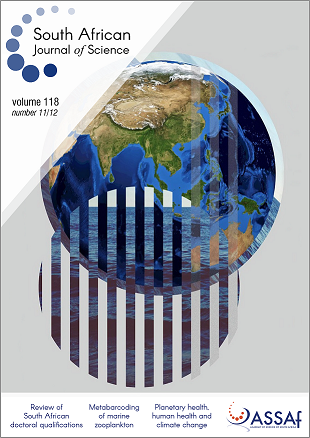Screening of zinc, copper and iron in lettuce and Chinese cabbage cultivated in Durban, South Africa, towards human health risk assessment
DOI:
https://doi.org/10.17159/sajs.2022/12099Keywords:
copper, zinc, iron, health risk assessment, transfer factorAbstract
Human well-being and ecological reliability continue to face a major threat resulting from heavy metal pollution to soils caused by untreated discharge from metropolitan and industrial wastewater. The potential human health risks of zinc (Zn), copper (Cu) and iron (Fe) contamination to native inhabitants through the food chain were assessed in Pinetown, Durban, where their irrigation processes are from the Umgeni River passing through the highly industrialised Pinetown area. River water, vegetables (cabbage and lettuce) and soil were analysed for Zn, Cu and Fe; transfer factor, health risk index and the daily intake of metals were also calculated. The concentrations of heavy metals indicated the pattern trend as Fe>Zn>Cu for both cabbage and lettuce. The levels of transfer factors for heavy metals ranged from 0.02 mg/kg to 1.89 mg/kg. The health risk index (0.0002–01430) was found to be within the recommended range (<1), which poses no human health risk with respect to all heavy metals tested.
Significance:
The present study has generated data on heavy metal pollution in and around the area and associated risk assessment for consumers’ exposure to the heavy metals. These data can assist decision-makers in understanding the suitability status of vegetable consumption and irrigation by providing an understanding of the human health risk of the studied area. This database can be used as a tool to pinpoint the mechanisms and processes influencing public health implications of heavy metals in foods, soils and water.
Published
Issue
Section
License

All articles are published under a Creative Commons Attribution 4.0 International Licence
Copyright is retained by the authors. Readers are welcome to reproduce, share and adapt the content without permission provided the source is attributed.
Disclaimer: The publisher and editors accept no responsibility for statements made by the authors
How to Cite
- Abstract 709
- PDF 618
- EPUB 253
- XML 282













.png)